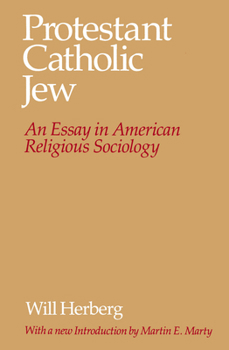Protestant--Catholic--Jew: An Essay in American Religious Sociology
Select Format
Select Condition 
Book Overview
"The most honored discussion of American religion in mid-twentieth century times is Will Herberg's Protestant-Catholic-Jew. . . . It] spoke precisely to the mid-century condition and speaks in still applicable ways to the American condition and, at its best, the human condition."--Martin E. Marty, from the Introduction "In Protestant-Catholic-Jew Will Herberg has written the most fascinating essay on the religious sociology of America that has appeared in decades. He has digested all the relevant historical, sociological and other analytical studies, but the product is no mere summary of previous findings. He has made these findings the basis of a new and creative approach to the American scene. It throws as much light on American society as a whole as it does on the peculiarly religious aspects of American life. Mr. Herberg. . . illumines many facets of the American reality, and each chapter presents surprising, and yet very compelling, theses about the religious life of this country. Of all these perhaps the most telling is his thesis that America is not so much a melting pot as three fairly separate melting pots."--Reinhold Niebuhr, New Yorks Times Book Review
Format:Paperback
Language:English
ISBN:0226327345
ISBN13:9780226327341
Release Date:October 1983
Publisher:University of Chicago Press
Length:326 Pages
Weight:0.77 lbs.
Dimensions:0.7" x 5.3" x 8.0"
Customer Reviews
3 ratings
Correction
Published by Thriftbooks.com User , 23 years ago
Great book, but Martin Marty is not an "illustrator."
We Live on Uncle Sam's Stove!
Published by Thriftbooks.com User , 23 years ago
Originally published in 1955, PROTESTANT-CATHOLIC-JEW is still worth reading and still significant. It is a good deal more than a tour of America's religions; it is a book about what it means to be an American. Herberg got a few things wrong, and a good deal has happened since 1955, but he was a wise man who was close to the mark on several important issues.//Briefly, Herberg argues that, contrary to Israel Zangwill and other theorists of a single assimilating melting pot, the United States has three melting pots: a Protestant melting pot, a Catholic melting pot, and a Jewish melting pot. According to Herberg, each subsequent generation of Americans considers itself less and less "ethnic." But as ethnic consciousness declines, religion becomes more important, so any intermarriage among different ethnic groups stays within the same religious denominations. For example, third-generation Polish-Americans (almost invariably Catholic) don't marry other Polish-Americans, but they do choose Catholic spouses. Their children become Catholic Americans, and part of the Catholic melting pot. // Herberg claims that the three melting pots are so important that there are now three fundamental ways of being an American. One can be a Protestant American, a Catholic American, or a Jewish American. The only exception Herberg makes is for the members of the Eastern Orthodox Church, whose intellectuals confuse everyone by insisting on Four Great Faiths rather than Three.//Herberg admits that the triple melting pot thesis has certain flaws. Specifically, he regards African Americans as a permanent outcast group that will likely never become part of the larger Protestant melting pot. (He says nothing about black Catholics and black Jews.) He also acknowledges the existence of a few members of various Eastern religious sects, but he clearly considers such people too marginal to think very hard about.//Within a few years of the publication of PROTESTANT-CATHOLIC-JEW, the whole idea of the melting pot--even a triple one--became unfashionable. Eminent scholars and politicians told us about "unmeltable ethnics." At the same time, religious intermarriage has become more common, making one wonder if the triple melting pot thesis is still valid. And, since the Immigration Reform Act of 1965, large numbers of Asians have moved to the United States, creating the outlines of a nation with Five Great Faiths: Christian, Jewish, Moslem, Buddhist, and Hindu. Unfortunately, Herberg himself is no longer around to interpret these trends, so we'll just have to sit here and cook for awhile.
Classic on American religious development
Published by Thriftbooks.com User , 25 years ago
Herberg brilliantly analyzes, with both insight and feeling, the development of the American religious landscape. We owe much of our cultural and religious identity to the waves of immigration that came to our shores and the particular ways in which these newcomers were assimilated to the American way. Our situation has changed somewhat since Heberg's work in 1960, but his careful, lucid, and detailed explanation of who we are is still highly worth reading. I warmly recommend it to my students.





